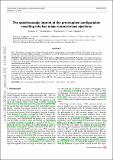Files in this item
The spectroscopic imprint of the pre-eruptive configuration resulting into two major coronal mass ejections
Item metadata
| dc.contributor.author | Syntelis, P. | |
| dc.contributor.author | Gontikakis, C. | |
| dc.contributor.author | Patsourakos, S. | |
| dc.contributor.author | Tsinganos, K. | |
| dc.date.accessioned | 2016-09-05T10:30:12Z | |
| dc.date.available | 2016-09-05T10:30:12Z | |
| dc.date.issued | 2016-04 | |
| dc.identifier | 245502544 | |
| dc.identifier | 0f530fcf-1fb1-4ed2-83a7-2f72ad9be6c8 | |
| dc.identifier | 84960959119 | |
| dc.identifier.citation | Syntelis , P , Gontikakis , C , Patsourakos , S & Tsinganos , K 2016 , ' The spectroscopic imprint of the pre-eruptive configuration resulting into two major coronal mass ejections ' , Astronomy & Astrophysics , vol. 588 , A16 . https://doi.org/10.1051/0004-6361/201526829 | en |
| dc.identifier.issn | 0004-6361 | |
| dc.identifier.other | BibCode: 2016A&A...588A..16S | |
| dc.identifier.other | ORCID: /0000-0002-6377-0243/work/77131785 | |
| dc.identifier.uri | https://hdl.handle.net/10023/9425 | |
| dc.description | P.S acknowledges financial support from the programme Aristotelis/SIEMENS at the NOA. | en |
| dc.description.abstract | Aims: We present a spectroscopic analysis of the pre-eruptive configuration of active region NOAA 11429, prior to two very fast coronal mass ejections (CMEs) on March 7, 2012 that are associated with this active region. We study the thermal components and the dynamics associated with the ejected flux ropes. Methods: Using differential emission measure (DEM) analysis of Hinode/EIS and SDO/AIA observations, we identify the emission components of both the flux rope and the host active region. We then follow the time evolution of the flux rope emission components by using AIA observations. The plasma density and the Doppler and non-thermal velocities associated with the flux ropes are also calculated from the EIS data. Results: The eastern and western parts of the active region, in which the two different fast CMEs originated during two X-class flares, were studied separately. In both regions we identified an emission component in the temperature range of log T = 6.8-7.1 associated with the presence of flux ropes. The time evolution of the eastern region showed an increase in the mean DEM in this temperature range by an order of magnitude, 5 h prior to the first CME. This was associated with a gradual rise and heating of the flux rope as manifested by blue-shifts and increased non-thermal velocities in Ca xv 200.97 Å, respectively. An overall upward motion of the flux ropes was measured (relative blue-shifts of ~12 km s-1). The measured electron density was found to be 4× 109-2 × 1010 cm-3 (using the ratio of Ca xv 181.90 Å over Ca xv 200.97 Å). We compare our findings with other works on the same AR to provide a unified picture of its evolution. | |
| dc.format.extent | 14 | |
| dc.format.extent | 3766688 | |
| dc.language.iso | eng | |
| dc.relation.ispartof | Astronomy & Astrophysics | en |
| dc.subject | Sun: coronal mass ejections (CMEs) | en |
| dc.subject | Sun: flares | en |
| dc.subject | Sun: activity | en |
| dc.subject | Sun: corona | en |
| dc.subject | QB Astronomy | en |
| dc.subject | QC Physics | en |
| dc.subject | NDAS | en |
| dc.subject.lcc | QB | en |
| dc.subject.lcc | QC | en |
| dc.title | The spectroscopic imprint of the pre-eruptive configuration resulting into two major coronal mass ejections | en |
| dc.type | Journal article | en |
| dc.contributor.institution | University of St Andrews. Applied Mathematics | en |
| dc.identifier.doi | https://doi.org/10.1051/0004-6361/201526829 | |
| dc.description.status | Peer reviewed | en |
| dc.identifier.url | http://adsabs.harvard.edu/abs/2016A%26A...588A..16S | en |
This item appears in the following Collection(s)
Items in the St Andrews Research Repository are protected by copyright, with all rights reserved, unless otherwise indicated.

